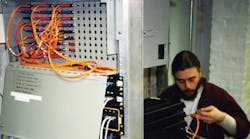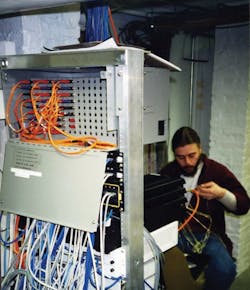Many electricians have broadened their work model in recent years to include coaxial and Ethernet wiring for communications and data networks. This is usually seen as a good move, given the fact that additional revenue streams become available without excessive overhead or investment during uncertain economic times. The reasons for pursuing low-voltage work are compelling. Unshielded twisted pair (UTP) cable is quite user-friendly, and it is in high demand on residential and commercial local area network (LAN) installations. Currently, Cat. 5e systems and beyond are adequate for network speeds most electricians encounter. However, that will inevitably change in the near future (see SIDEBAR: Connectivity Trends).
Because of its obvious benefits, there are compelling reasons to go with optical fiber. So if you haven’t already done so, it’s time to start accumulating knowledge and certification in this area.
A look inside optical
Although they involve some specialized skills, installation techniques are definitely doable for electricians with this product. These will be discussed later on in the article, but first let’s take a look at the basics of how optical fiber works.
If you’ve ever skipped a stone across a pond, you can understand exactly what is happening inside an optical fiber. To avoid penetrating the surface and sinking to the bottom, the stone must travel at a fast pace — almost parallel to the air/water interface. That way, its inertia carries the stone along with sufficient force (at a small angle) so as not to break through into the other medium. This is what happens inside an optical fiber. The inner core that carries the light particles (or waves, depending on how you want to think about them) has a higher index of refraction than the outer cladding. Consequently, the light bounces from side to side, almost totally reflected so that little loss occurs. Very long distance transmission is possible — up to 100 miles as opposed to the 300-foot limit for UTP cabling.
An optical fiber is a special case of a waveguide — a hollow tube that conveys various forms of radiation by means of total internal reflection. The diameter of the waveguide must be of the same order of magnitude as the wavelength of the energy conveyed. The waveguide for a radio telescope, carrying the output from the dish to the receiver, is massive and best set with a crane. The waveguide connected to a TV satellite dish, on the other hand, weighs only a couple of pounds. For still higher frequencies, a pair of tweezers is used to position a waveguide so that it can be attached to a printed circuit board. Waveguides also carry sound. Most of us know that the song of a whale can be heard at enormous distances. This is because thermal layers in the ocean form a huge waveguide that is appropriate for the low frequencies that are conveyed.
At the other end of the scale, visible light contains wavelengths in the hundreds of nanometers, so some optical fibers resemble a human hair. The two discrete types of optical fiber comprise single-mode and multi-mode. Multi-mode optical fiber has a much larger core diameter than single-mode. Multi-mode fiber usually has up to a 100-micrometer diameter. This is much larger than the wavelength of light being conveyed. Consequently, multi-mode is easier to terminate. The problem is, because multi-mode carries light of various wavelengths simultaneously — and these signals travel at different rates — distortion occurs if the cable length is too long. For high-speed performance, multi-mode has a distance limit of around 1,000 feet. Because it has a larger aperture, less expensive equipment is required at the terminations. For single-mode, lasers are used as the signal source, while for multi-mode, LEDs often suffice. Other than size, the two types of optical fiber can be distinguished by jacket color — yellow for single-mode, orange for multi-mode, and aqua for multi-mode optimized for laser.
Application options
Optical fiber work falls into either of two categories. Premises installations are inside the building or short (generally underground) runs between nearby buildings under single ownership. This work is done by electricians who have decided to branch out into this upscale field or by technicians specializing in fiber optics and low-voltage installation work. Utility-scale outdoor work is a totally different trade, performed by the network providers with their own crews or sometimes by high-tech contractors. Premises work requires a small initial investment in equipment. In addition to standard electricians’ tools (including conduit benders, hole saws, fish tapes, long drill bits, etc.), essential items include a fiber-optic power meter (in conjunction with a test source and connector adapters), a flashlight-type source for visual tracing, and a specialized microscope for inspecting terminations. For indoor work, splicing is not generally done, because the typical short runs can be made of unbroken segments. The lower-tech multi-mode cable is used.
In contrast, outside fiber-optic work requires significant capitalization. To get started, you’ll need a temperature-controlled van for making the fusion splices, a bucket truck, a trencher, a backhoe, and a flatbed for hauling it. As for test equipment, the optical time-domain reflectometer (OTDR), typically priced at less than $5,000 for a good one with launch and receive cables, is needed.
The OTDR, which resembles the time-domain reflectometer that is used for copper network cabling, is connected to either end of an optical fiber. It feeds in light pulses and receives/records any reflections due to defects and anomalies anywhere along the line. To accurately set up the machine with proper cabling hookups, perform the tests, and interpret the results, a large amount of training and experience is necessary. OTDR readings are taken throughout manufacturing, warehousing, and shipping operations. The careful installer will use this instrument to check cable integrity on the reel immediately prior to installation.
For long runs, the OTDR finds and reports the distance to a fault, so underground lines (often direct buried without conduit) can be accessed at the fault without digging up the whole line. The OTDR does not work on short segments, and is not used in most premises cabling work.
For outside work, fiber-optic cable is often spliced. This is because maximum reel lengths are under three miles, and total runs are often much longer. Fusion splicing makes the best joint. Ends are scored, cleaved, polished, and inspected, and then heated by means of an electric spark so that they melt and fuse.
Reaping the benefits
Optical fiber has several significant advantages over copper in terms of performance:
• Optical fiber is immune to electromagnetic interference (EMI) and is never the cause of it. There is no crosstalk, and it is ideal for noisy industrial environments with lots of motors and fluorescent ballasts.
• There is complete electrical isolation between input and output.
• For non-composite fiber, there is no danger of electric shock to installers or end-users.
• Much greater bandwidth is available over long distances.
• Fewer repeaters are needed to boost an attenuated signal.
• Lightweight, small diameter means less labor to run the cable.
Price volatility of both media and a changing labor pool make a definitive cost comparison problematic. For long runs with heavy data requirements, optical fiber has a clear advantage. No one in his right mind would lay a transatlantic data cable in copper, for example, but UTP is the way to go for a two-computer LAN in a residential setting.
NEC considerations
Fiber-optic installations are covered by the National Electrical Code (NEC). Your jurisdiction may not require licensing for low-voltage and data cabling work. However, as part of the overall electrical installation, the inspector will be looking at optical fiber for NEC compliance. You may wonder why this is necessary, since non-composite fiber does not carry the kind of energy that could be a shock hazard or ignite combustible material. The hazards addressed in 2011 NEC for the most part fall into two categories. Even though fire cannot be initiated by the energy that non-composite optical fiber conveys, these cables can contribute to propagation of fire from some other source. Secondly, the jacket material of fiber-optic cable (once ignited) can contribute a large amount of thick, choking smoke.
The NEC mitigates these hazards by requiring that abandoned fiber-optic cable be removed. This parallels an identical requirement for low-voltage and communications cabling in general, as covered in their respective Code articles. Interestingly enough, it does not apply to power and light wiring. Abandoned fiber-optic cable is defined as that which is not terminated at equipment other than a connector and not identified for future use with a tag.
Additionally, it is provided that access to electrical equipment is not to be denied by an accumulation of optical fiber cables that prevents removal of panels, including suspended ceiling panels. This means that it is not permitted to lay optical fiber cables directly on the suspended ceiling panels. They must be properly supported and secured at a higher level. In addition, like all wiring, they may not be cable tied to the nearest convenient conduit or raceway (frequently the practice), because this could add weight and impede heat dissipation.
A further set of requirements that seeks to confront these same problems is collectively known as the hierarchy of cable types. Fiber-optic cable (like coax or UTP) jackets are made of various materials that differ in fire propagation and smoke generation properties. The unfortunate fact is that the safer of these cable types is also the more costly. Accordingly, they are rated for (and their use permitted in) selected areas, depending upon the sensitivity of the location. These locations, starting with the most potentially hazardous, are:
• Plenum, defined as spaces used for environmental air, excluding fabricated ducts. These do not include an entire room that is part of a building’s air flow, but they do include the space above a suspended ceiling that is used for environmental air.
• Riser, defined as a vertical run penetrating one or more floors and a vertical run in a shaft.
• General-purpose optical fiber is permitted in other than the above locations, including one- and two-family dwellings.
Each of the locations requires that optical fiber cable for use therein be rated as suitable. The cable use can be determined by the final letter in the marking. For example, OFNR denotes non-conductive riser-rated optical fiber. The interesting fact is that the higher-rated cables are permitted to be substituted for cables listed for less restrictive applications. Thus, plenum-rated cable can be used is riser locations, but riser-rated cable cannot be used in a plenum area. (The same basic scheme is used for other low-voltage and communications cables, with some variations.)
Other Code requirements that pertain to fiber-optic installations include grounding. Non-current-carrying conductive components of the system, such as metallic armor, are to be grounded and bonded ultimately back to the ground lug in the building’s service entrance enclosure and grounding electrode system. This may be accomplished by means of the connector bonded to the upstream enclosure in the usual fashion. Any metallic raceways or cable trays are to be similarly bonded and grounded.
Safety first
Optical fiber is generally considered a fairly non-hazardous medium, but some safety concerns do exist. Small fragments of the fiber are very sharp — much more so than broken window glass. Therefore, you need to protect yourself and others.
First, always wear safety glasses with good side panels, and keep an extra pair on hand in case someone enters the work area. Do not smoke, eat, or drink in the vicinity. Any cutting or other end preparation should be done over a black mat so that glass particles will be visible. Keep a small container handy to collect these fragments. Later, seal up the container with duct tape, and dispose of it properly. Second, isopropyl alcohol, used for cleaning terminations, is flammable and toxic, as are various adhesives and other chemicals you may use. Thus, it is important to take appropriate action to prevent human exposure. In addition, when working in a trench or with a bucket truck, beware of the specific hazards involved, and make sure you have the necessary training to work safely.
As we have seen, fiber-optic cabling, especially within the premises, presents a bit of a learning curve, not unlike electrical wiring in general. Although on-the-job experience is a key part of the picture, Internet and print resources are of great value as well. An especially useful website is www.thefoa.org, maintained by the Fiber Optic Association, a non-profit professional society. The site contains voluminous free educational material leading to certification in the field.
Herres is a licensed master electrician in Stewartstown, N.H. He can be reached at [email protected].
SIDEBAR: Connectivity Trends
With more people connecting to networks every day — coupled with the greater demands being placed on those networks because of graphics, music, streaming video, etc. — existing cable eventually will lack sufficient bandwidth to do the job.
Currently, Cat. 5e is used for most applications. The “e” means “enhanced.” After Cat. 6 was made available, it was quickly replaced by Cat. 6a. The “a” means “augmented.”
Although much faster than Cat. 5e, Cat. 6 is much more expensive; thus, most applications stick with Cat 5e. Cat. 7 has also been developed, but it has not become generally accepted yet. All of these choices (beyond Cat. 5e) will inevitably become moot as the price of optical fiber drops and simpler installation hardware becomes available.




